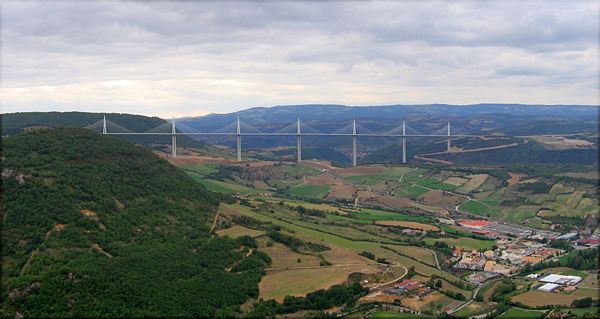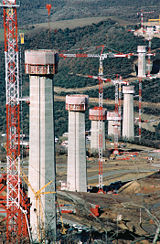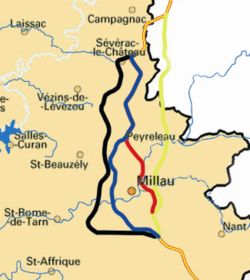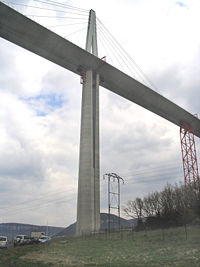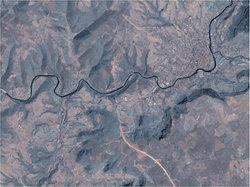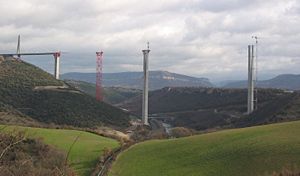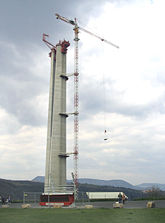Millau Viaduct
2008/9 Schools Wikipedia Selection. Related subjects: Architecture
| Millau Viaduct | |
|---|---|
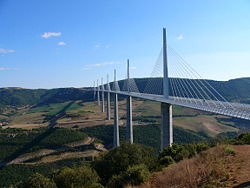 |
|
| Official name | Le Viaduc de Millau |
| Carries | 4 lanes of the A75 autoroute |
| Crosses | Valley of the River Tarn |
| Locale | Millau, France |
| Design | Cable-Stayed |
| Longest span | 342 m (1,122 ft) |
| Total length | 2,460 metres (8,071 ft) |
| Width | 32 m (105 ft) |
| Clearance below | 270 m (886 ft) at maximum |
| Opening date | December 14, 2004 |
The Millau Viaduct (French: le Viaduc de Millau) is a large cable-stayed road-bridge that spans the valley of the River Tarn near Millau in southern France. Designed by Lord Foster of Foster and Partners, and bridge engineer Michel Virlogeux, it is the tallest vehicular bridge in the world, with one mast's summit at 343 metres (1,125 ft) — slightly taller than the Eiffel Tower and only 38 m (125 ft) shorter than the Empire State Building. The viaduct is part of the A75-A71 autoroute axis from Paris to Béziers. It was formally dedicated on 14 December 2004 and opened to traffic two days later.
Construction records
The bridge’s construction broke three world records:
- The highest pylons in the world: pylons P2 and P3, 244.96 and 221.05 metres in height respectively, broke the French record previously held by the Tulle and Verrières Viaducts (141 m), and the world record previously held by the Kochertal Viaduct (Germany), which is 181 metres at its highest;
- The highest mast in the world: the mast atop pylon P2 peaks at 343 m.
- The highest road bridge deck in the world, 270 m above the Tarn River at its highest point. It is nearly twice as tall as the previous tallest vehicular bridge in Europe, the Europabrücke in Austria. It is slightly higher than the New River Gorge Bridge in West Virginia in the United States, which is 267 m above the New River. Only the bridge deck of the Royal Gorge Bridge in Colorado, United States (mainly a pedestrian bridge over the Arkansas River, occasionally also used by motor vehicles) is higher with 321 m, and is considered the highest bridge in the world.
The record for highest bridge deck in the world is likely to be taken by the Chenab Bridge in the Reasi District of Jammu and Kashmir, India, scheduled for completion in December 2009, which will be 359 metres high.
Location
Millau Viaduct is located in Millau, France, in the Département of Aveyron. Before the bridge was constructed, traffic had to descend into the Tarn River valley and pass along the route nationale N9 near the town of Millau, causing heavy congestion at the beginning and end of the July and August vacation season. The bridge now traverses the Tarn valley above its lowest point, linking the Causse du Larzac to the Causse Rouge, and is inside the perimeter of the Grands Causses regional natural park.
The bridge forms the last link of the A75 autoroute, (la Méridienne) from Clermont-Ferrand to Pézenas (to be extended to Béziers by 2010). The A75, with the A10 and A71, provides a continuous high-speed route south from Paris through Clermont-Ferrand to the Languedoc region and through to Spain, considerably reducing the cost of vehicle traffic travelling along this route. Many tourists heading to southern France and Spain follow this route because it is direct and without tolls for the 340 km between Clermont-Ferrand and Pézenas, except for the bridge itself.
The Eiffage group operates the viaduct as a toll bridge, with the toll currently (Nov 2007) set at €5.40 for light automobiles (€7.00 during the peak months of July and August). The bridge was constructed by the Eiffage group, under a government contract which allows the company to collect tolls for up to 75 years.
North-South axes
As of 2007, there are four north-south routes, or axes, traversing France:
- In the east, the Paris- Lyon- Vallée du Rhône route using the A6 and A7 autoroutes;
- In the west, the Paris- Bordeaux- Agen- Toulouse route using the A10 and A62 autoroutes;
- Centrally, west of the Massif Central, the Vierzon- Limoges- Brive- Toulouse route using the A20;
- Centrally, through the Massif central and using the Millau Viaduct, the Clermont-Ferrand- Béziers route using the A75.
A75 autoroute
Construction started in 1975 and was finished in 2004 when the Millau Viaduct went into service.
The new A75 autoroute, complementing the A71 from Orléans to Clermont-Ferrand, created a fourth route through France and has several advantages:
- It relieves traffic congestion in the Rhone Valley which connects Northern Europe with Spain and Portugal, and allows holiday-makers to reach the Mediterranean quickly;
- It also opens up the Massif central and the town of Clermont-Ferrand to the south;
- It enhances the French motorway network and, in a wider perspective, facilitates travel between Northern Europe and the Île de France on one hand, and on the other, Spain and the west Mediterranean region.
Bypassing Tarn at Millau
The Tarn flows from the east to the west of France, south of the Massif Central, bisecting the country's North-South axis.
For nearly thirty years prior to the construction of the Millau Viaduct, the A75 autoroute had remained unfinished. Before the bridge, a crossing of the River Tarn was provided by a bridge situated in the valley bottom, in the town of Millau. Millau was then known and dreaded as a ‘great black spot’ of motoring. Kilometres of congestion and hours of waiting to transit the town recurred each year with the great surge in traffic in summer months. These slowdowns meant that the advantages of the A75 were lost. The A75 was meant to be a positive example of spatial planning, a modern, direct highway entirely free along its 340 km length. As it was, the traffic from the autoroute brought pollution and danger to the town of Millau.
Design and construction of the bridge took a long time. In this region, climatic conditions are tough, with violent winds. Geological characteristics of the high plateaus of Larzac are peculiar, and, because the Tarn Valley is so deep, crossing is difficult. Different approaches were investigated, and all of them were found to be very technically demanding. Ten years of research and four years of implementation were required for completion of the Millau Viaduct.
Description
The Millau Viaduct consists of an eight-span steel roadway supported by seven concrete pylons. The roadway weighs 36,000 tons and is 2,460 m long, measuring 32 m wide by 4.2 m deep, making it the world's longest cable-stayed deck. The six central spans each measure 342 m with the two outer spans measuring 204 m. The roadway has a slope of 3% descending from south to north, and curves in a plane section with a 20 km radius to give drivers better visibility. It carries two lanes of traffic and one safety lane in each direction.
The pylons range in height from 77 to 246 m, and taper in their longitudinal section from 24.5 m at the base to 11 m at the deck. Each pylon is composed of 16 framework sections, each weighing 2,230 tons. These sections were assembled on site from pieces of 60 tons, 4 m wide and 17 m long, made in factories in Lauterbourg and Fos-sur-Mer by Eiffage. The pylons each support 97 m tall masts.
The pylons were assembled first, together with some intermediate temporary pylons, before the decks were slid out across the piers by satellite-guided hydraulic rams that moved the deck 600 mm every 4 minutes. Then the masts were driven over the new deck, erected on top of the pylons, connected to the deck and the temporary pylons removed.
Construction began on 10 October 2001 and was intended to take three years, but weather conditions put work on the bridge behind schedule. A revised schedule aimed for the bridge to be opened in January 2005. The viaduct was inaugurated by President Chirac on 14 December 2004 to open for traffic on 16 December, several weeks ahead of the revised schedule.
The construction of the bridge was depicted in an episode of the National Geographic Channel " MegaStructures" series.
Pylons and abutments
Each pylon is supported by four deep shafts, 15 m deep and 5 m in diameter.
| P1 | P2 | P3 | P4 | P5 | P6 | P7 |
|---|---|---|---|---|---|---|
| 94.501 m | 244.96 m | 221.05 m | 144.21 m | 136.42 m | 111.94 m | 77.56 m |
All the pylons are 97 m tall.
The abutments are concrete structures that provide anchorage for the deck to the ground in the Causse du Larzac and the Causse Rouge.
Deck
The metallic deck, which appears very light despite its total mass of around 36,000 metric tonnes, is 2,460 m long and 32 m wide. It comprises eight spans. The six central spans measure 342 m, and the two outer spans are 204 m. These are composed of 173 central box beams, the spinal column of the construction, onto which the lateral floors and the lateral box beams were welded. The central box beams have a 4 m cross-section and a length of 15–22m for a total weight of 90 tonnes. The deck has an inverse airfoil shape, providing negative lift in strong wind conditions.
Masts
The seven masts, each 88.92 m high and weighing around 700 tonnes, are set on top of the pylons. Between each of them, eleven stays (metal cables) are anchored, providing support for the road deck.
Stays
Each mast of the viaduct is equipped with a monoaxial layer of eleven pairs of stays laid face to face. Depending on their length, the stays were made of 55 to 91 high tensile steel cables, or strands, themselves formed of seven strands of steel (a central strand with six intertwined strands). Each strand has triple protection against corrosion ( galvanisation, a coating of petroleum wax and an extruded polyethylene sheath). The exterior envelope of the stays is itself coated along its entire length with a double helical weatherstrip. The idea is to avoid running water which, in high winds, could cause vibration in the stays and compromise the stability of the viaduct.
The stays were installed by the Freyssinet company.
Surface
To allow for deformations of the metal deck under traffic, a special surface of modified bitumen was installed by research teams from Appia. The surface is somewhat flexible to adapt to deformations in the steel deck without cracking, but it must nevertheless have sufficient strength to withstand motorway conditions (fatigue, density, texture, adherence, anti-rutting, etc.). The "ideal formula" was found only after ten years of research.
Electrical installations
The electrical installations of the viaduct are impressive, in proportion to the immensity of the bridge. There are 30 km of high-current cables, 20 km of fibre optics, 10 km of low-current cables and 357 telephone sockets allowing maintenance teams to communicate with each other and with the command post. These are situated on the deck, on the pylons and on the masts.
As far as instrumentation is concerned, the viaduct is state of the art. The pylons, deck, masts and stays are equipped with a multitude of sensors. These are designed to detect the slightest movement in the viaduct and measure its resistance to wear-and-tear over time. Anemometers, accelerometers, inclinometers, temperature sensors are all used for the instrumentation network.
Twelve fibre optic extensometers were installed in the base of pylon P2. The tallest of all, it is therefore under the most intense stress. These sensors detect movements on the order of a micrometre. Other extensometers — electrical this time — are distributed on top of P2 and P7. This apparatus is capable of taking up to 100 readings per second. In high winds, they continuously monitor the reactions of the viaduct to extreme conditions. Accelerometers placed strategically on the deck monitor the oscillations that can affect the metal structure. Displacements of the deck on the abutment level are measured to the nearest millimetre. The stays are also instrumented, and their ageing meticulously analysed. Additionally, two piezoelectric sensors gather traffic data: weight of vehicles, average speed, density of the flow of traffic, etc. This system can distinguish between fourteen different types of vehicle.
The data are transmitted by an Ethernet network to a computer in the IT room at the management building situated near the toll plaza.
Toll plaza
The only toll plaza on the A75 autoroute, the bridge toll booths and the buildings for the commercial and technical management teams are situated 4 km north of the viaduct. The toll plaza is protected by a canopy in the shape of a leaf (formed from tendrilled concrete, using the ceracem process). Consisting of 53 elements ( voussoirs), the canopy is 100 m long and 28 m wide. It weighs around 2,500 tonnes.
The toll plaza can accommodate sixteen lanes of traffic, eight in each direction. At times of low traffic volume, the central booth is capable of servicing vehicles in both directions. A car park and viewing station, equipped with public toilets, is situated each side of the toll plaza. The total cost was €20 million.
Preliminary studies
Chronology
- 1987: Establishment of the first plans by CETE of Aix-en-Provence;
- 19 October 1991: Choice of the high crossing of the Tarn River by a structure of around 2,500 m;
- 1993–1994: Separate consultations with seven architects and eight structural engineers;
- 1995–1996: Second definition study with five associated architect groups and structural engineers;
- 10 January 1995: Declaration of public interest;
- 9 July 1996: The jury decides in favour of a cable-stayed design with multiple spans, as proposed by the Sogelerg consortium ( Michel Virlogeux and Norman Foster);
- 20 May 1998: Decision to proceed by grant of contract;
- 8 June 2000: Launch of the contest for the construction contract, open to four consortia;
- March 2001: Eiffage establishes the subsidiary Compagnie Eiffage du Viaduc de Millau (CEVM) and is declared winner of the contest and awarded the prime contract;
- August 2001: Ratification by the State Council on the project, allotting the contract to Eiffage by ministerial decree ;
- 8 October 2001: Decree formally approving the grant of contract.
Possible routes
In initial studies, four options were examined:
- An option called Great Eastern (grand Est) ( green route ) passing east of Millau and crossing the valleys of the Tarn and Dourbie on two very high and long bridges (spans of 800 and 1,000 m) whose construction was acknowledged to be problematic. This option would have allowed access to Millau only from the Larzac plateau using the long and tortuous descent from La Cavalerie. Although this option was shorter and better suited to the through traffic, it was abandoned because it did not serve the needs of Millau and its area satisfactorily.
- An option called the Great Western (grand Ouest) ( black route ), longer than the eastern option by 12 km, following the Cernon valley. Technically easier (requiring four viaducts), this solution was judged to have negative impacts on the environment, in particular on the picturesque villages of Peyre and Saint-Georges-de-Luzençon. More expensive than the preceding option, and serving the region badly, this option was also abandoned.
- An option called near RN9 (proche de la RN9) ( red route ), would have served the town of Millau well, but presented technical difficulties and would have had a strong impact on existing or planned structures. This option was also abandoned.
- An option called intermediate (médiane), west of Millau ( blue route ) had the blessing of local opinion, but presented geological difficulties, notably on the question of crossing the valley of the Tarn. Expert investigation concluded that these obstacles were not insurmountable.
The fourth option was selected by the ministerial decree on 28 June 1989. It encompassed two possibilities:
- the high solution, envisaging a 2,500 m viaduct more than 200 m above the river;
- the low solution, descending into the valley and crossing the river on a 200 m bridge, then a viaduct of 2,300 m extended by a tunnel on the Larzac side.
After long construction studies by the Ministry of Public Works, the low solution was abandoned because it would have intersected the water table, had a negative impact on the town, cost more, and lengthened the driving distance.
The choice of the “high” solution was decided by ministerial decree on October 29, 2001.
After the choice of the high viaduct, five teams of architects and researchers worked on a technical solution. The concept for the bridge was devised by French designer Michel Virlogeux. The architects of the bridge are the British firm Foster and Partners. They worked with the Dutch engineering firm ARCADIS, responsible for the structural engineering of the bridge.
Choosing the definitive route
The "high solution" required the construction of a 2500 m long viaduct. Obviously, this would be the crown jewel of the entire A75 autoroute project. From 1991 to 1993, the structures division of Sétra, directed by Michel Virlogeux, carried out preliminary studies and examined the feasibility of a single structure spanning the valley. Taking into account technical, architectural and financial issues, the Administration of Roads then opened the question for competition between structural engineers and architects to widen the search for realistic designs. By July 1993, 17 structural engineers and 38 architects presented themselves as candidates for the preliminary studies. With the assistance of a multidisciplinary commission, the Administration of Roads selected 8 structural engineers for technical study and 7 architects for the architectural study.
Choice of technical design
Simultaneously, a school of international experts representing a wide spectrum of expertise (technical, architectural and landscape), chaired by Jean-François Coste, was established to clarify the choices which had to be made. In February 1994, on the basis of proposals of the architects and structural engineers, and with support of the school of experts, five general designs were identified.
The competition was relaunched: five combinations of architects and structural engineers, drawn from the best candidates of the first phase, were formed to each conduct in-depth studies of one of the general designs. On 15 July 1996, Bernard Pons, minister of Public Works, announced the decision of the jury constituted of elected artists and experts and chaired by the director of highways, Christian Leyrit at the time. The solution of a suspended bridge, presented by the group of research bureaus Sogelerg, Europe Etudes Gecti and Serf and the architecture group Norman Foster & Partners was declared the best.
Detailed studies were carried out by the successful consortium, steered by the highways authority until mid-1998. After wind tunnel tests, the shape of the road deck was altered and detailed corrections were made to the design of the pylons. When the details were eventually finalised, the whole design was approved in late 1998.
Contractors
Once the Ministry of Public Works had taken the decision to offer the construction and operation of the viaduct as a grant of contract, an international call for tenders was issued in 1999. Four consortia tendered:
- Compagnie Eiffage du Viaduc de Millau (CEVM), led by Eiffage
- a consortium led by the Spanish company Dragados, with Skanska (Sweden), and Bec (France)
- Société du Viaduc de Millau, including the French companies ASF, Egis, GTM, Bouygues Travaux Publics, SGE, CDC Projets, Tofinso and the Italian company Autostrade
- a consortium led by Générale Routière, with Via GTI (France) and Cintra, Nesco, Acciona et Ferrovial Agroman (Spain).
The Compagnie Eiffage du Viaduc de Millau, working with the architect Sir Norman Foster, was successful in obtaining the tender. The fact that the government had already taken the design work to an advanced stage meant that the technical uncertainties were considerably reduced. A further advantage was that it made the process of negotiating the contract easier, reducing public expense and speeding up construction, while minimising such design work as remained for the contractor.
All the member companies of the Eiffage group had some role in the construction work. The construction consortium was made up of the Eiffage TP company for the concrete part, the Eiffel company for the steel roadway ( Gustave Eiffel built the Garabit viaduct in 1884, a railway bridge in the neighboring Cantal département), and the ENERPAC company for the roadway's hydraulic supports. The engineering group Setec has authority in the project, with SNCF engineering having partial control.
Appia was responsible for the job of the bituminous coating on the bridge deck, and Forclum for electrical installations. Management was handled by Eiffage Concessions.
The only other business that had a notable role on the building site was Freyssinet, a subsidiary of the Vinci Group specialising in prestressing, which was entrusted with installing the cable stays and putting them under tension, while the prestress division of Eiffage was responsible for prestressing the pillar heads.
The steel deck and the hydraulic action of the deck (the technical solution that had been successful in the competition for the design of the metallic moving parts) were designed by the engineering firm Greisch (BEG) from Liège. They carried out the general calculations and the resistance calculations for winds of up to 225 km/h.
The sliding shutter technology for the bridge piers came from PERI.
Opposition
Numerous organizations opposed the project, including the WWF, France Nature Environnement, the national federation of motorway users, and Environmental Action. Opponents put forward several arguments:
- The westernmost route would be better, longer by three kilometres but a third of the cost with its three more conventional structures.
- The objective of the viaduct would not be achieved; because of the toll, the viaduct would be little used and the project would not solve Millau's congestion problems.
- The project would never break even; toll income would never amortise the initial investment and the contractor would have to be supported by subsidies.
- The technical difficulties were too great and the bridge would be dangerous and unsustainable; the pylons, sitting on the shale of the Tarn Valley, would not support the structure adequately.
- The viaduct represented a detour, reducing the number of visitors passing through Millau and slowing its economy.
Statistics
- 2,460 m: total length of the roadway
- 7: number of piers
- 77 m: height of Pier 7, the shortest
- 343 m: height of Pier 2, the tallest (245 m at the roadway's level)
- 89 m: height of a mast
- 154: number of shrouds
- 270 m: average height of the roadway
- 4.20 m: thickness of the roadway
- 32.05 m: width of the roadway
- 85,000 m³: total volume of concrete used
- 290,000 tonnes: total weight of the bridge
- 10,000–25,000 vehicles: estimated daily traffic
- €5.40–7.00: typical automobile toll, as of July 2007
- 20 km: horizontal radius of curvature of the road deck
Construction
Project timeline
- 16 October 2001: work begins
- 14 December 2001: laying of the first stone
- January 2002: laying pier foundations
- March 2002: start of work on the pier support C8
- June 2002: support C8 completed, start of work on piers
- July 2002: start of work on the foundations of temporary, height adjustable roadway supports
- August 2002: start of work on pier support C0
- September 2002: assembly of roadway begins
- November 2002: first piers complete
- 25 February– 26 February 2003: laying of first pieces of roadway
- November 2003: completion of the last piers (Piers P2 at 245 m and P3 at 221 m are the highest piers in the world.)
- 28 May 2004: the pieces of roadway are several centimetres apart, their juncture to be accomplished within two weeks
- 2nd half of 2004: installation of the pylons and shrouds, removal of the temporary roadway supports
- 14 December 2004: official inauguration
- 16 December 2004: opening of the viaduct, ahead of schedule
- 10 January 2005: initial planned opening date
Pylons and abutments
Two weeks after the laying of the first stone on 14 December 2001, the workers started to dig the deep shafts. There were 4 per pylon; 15 m deep and 5 m in diameter, assuring the stability of the pylons. At the bottom of each pylon, a tread of 3–5 m in thickness was installed to reinforce the effect of the deep shafts. The 2000 m³ of concrete necessary for the treads was poured at the same time.
In March 2002, the pylons emerged from the ground. The speed of construction then rapidly increased. Every three days, each pylon increased in height by 4 m. This performance was mainly due to sliding shuttering. Thanks to a system of shoe anchorages and fixed rails in the heart of the pylons, a new layer of concrete could be poured every 20 minutes.
Rolling out of the deck
The bridge deck was constructed on land at the ends of the viaduct and rolled lengthwise from one pylon to the next, with eight temporary towers providing additional support. The movement was accomplished by a computer-controlled system of pairs of wedges under the deck; the upper and lower wedges of each pair pointing in opposite directions. These were hydraulically operated, and moved repeatedly in the following sequence:
- The lower wedge slides under the upper wedge, raising it to the roadway above and then forcing the upper wedge still higher to lift the roadway.
- Both wedges move forward together, advancing the roadway a short distance.
- The lower wedge retracts from under the upper wedge, lowering the roadway and allowing the upper wedge to drop away from the roadway; the lower wedge then moves back all the way to its starting position. There is now a linear distance between the two wedges equal to the distance forward the roadway has just moved.
- The upper wedge moves backward, placing it further back along the roadway, adjacent to the front tip of the lower wedge and ready to repeat the cycle and advance the roadway by another increment.
Erection of masts
The mast pieces were driven over the new deck, welded together and erected on top of the pylons. The stays connecting the masts and the deck were installed, and the temporary pylons were removed.
Impact and events
On the local economy
Thanks to the “viaduct effect”, the mayor of Millau approved more than 100 building permits in 18 months for the construction of three hotels plus other businesses and industries. Millau has seen an economic boom since the bridge opened.
The two industrial zones in La Cavalerie to the south, and Sévérac-le-Château to the north, have both expanded greatly, accommodating new enterprises both local and national.
Pedestrian sporting events
Unusually for a bridge closed to pedestrians, a run has already taken place in 2004 and another on 13 May 2007:
- December 2004 - 19,000 walkers and runners of the Three Bridge Walk had the privilege of crossing the bridge deck for the first time, but the walk was not authorised to go further than pylon P1; the bridge was still closed to traffic.
- 13 May 2007 - 10,496 runners took the departure of the race which from Place de Mandarous, in the centre of Millau, to the southern end of the viaduct. After starting on the northern side, they crossed the viaduct then retraced their steps. Total distance: 23.7 km.
It appears that such events are unlikely to happen again.
Famous visitors
During construction, various personalities flocked to the bridge. Amongst those:
- Jacques Chirac for the opening ceremony 14 December 2004;
- The Duke of Edinburgh ( 28 May 2004);
- José Bové ( 30 April 2004);
- Jean-Pierre Raffarin ( 7 April 2004);
- Gilles de Robien ( 24 January 2003 and 14 December 2004);
- Marc Blondel ( 9 December 2003);
- Sir Norman Foster ( 17 October 2003 and 14 December 2004);
- Dominique Bussereau ( 29 September 2003);
- Henri Salvador (in 2002);
- Roselyne Bachelot-Narquin (October 2002);
- Jean-Claude Gayssot ( 14 December 2001).
- Jeremy Clarkson, Richard Hammond and James May, presenters of BBC's Top Gear;
- Andrew Spruce and George Brass, engineers;
Miscellanea
- In 2004, a fire started on the slope of causse rouges because of a spark originating from a welder. Some trees were destroyed.
- The speed limit on the bridge was reduced from 130 to 110 km/h because of traffic slowing down, due to tourists taking pictures of the bridge from the vehicles. Shortly after the bridge opened to traffic, passengers were stopping on the hard shoulder to admire the landscape and the bridge itself.
- A stamp was designed by Sarah Lazarevic to commemorate the opening of the crossing.
- The Chinese transport minister at the time visited the bridge on the first anniversary of its opening. The commission was impressed by the technical prowess of the bridge’s immense construction, but also by the legal and financial assembly of the viaduct. However, according to the minister, he did not envisage building a counterpart in People's Republic of China.
- The cabinet of the governor of California Arnold Schwarzenegger, who envisaged the construction of a bridge in San Francisco Bay, asked the council of the town hall of Millau about the popularity of the construction of the viaduct.
- This bridge was featured in a scene of Mr. Bean's Holiday.
